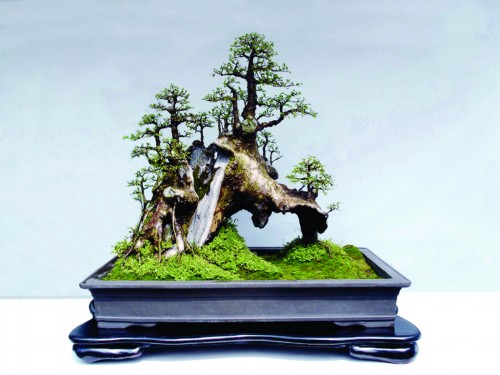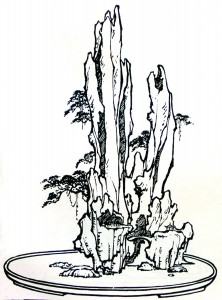 A magical Chinese elm penjing by Wang Huaishun. Did this creative landscape, and others like it, influence some of Kimura’s more daring innovations? Robert Steven’s too? From Bonsai Today issue 98. Submitted by Karin Albert.
A magical Chinese elm penjing by Wang Huaishun. Did this creative landscape, and others like it, influence some of Kimura’s more daring innovations? Robert Steven’s too? From Bonsai Today issue 98. Submitted by Karin Albert.
Penjing in three parts
The Penjing above is the lead photo in a wonderful (and very well received) in-depth article entitled, Penjing: A Chinese Renaissance by Karin Albert, that appear in Bonsai Today issues 98, 101 and 102.
Following the buzz
There’s been a lot of buzz from Robert’s last critique a few posts back: Robert Steven Critiques a Black Pine and Offers Some Insights into the Five Schools of Penjing. So this seems like a good time to throw Karin’s insights into the mix.
A small taste to whet your appetite
“In bonsai literature we read that the literati style in bonsai is patterned after the way painters of China’s Southern School rendered their trees, indicating that at the time literati bonsai was conceived, but only in this one instance, bonsai artists were inspired by a particular genre of Chinese painting. This interpretation is much too narrow. In reality, China’s literati were the original creators of the entire art of miniature trees and landscapes, not just a segment. (this bold type does not appear in the original). Their influence was pervasive throughout.” From the second installment (China’s Literati: The Cultural Context of Penjing) of Karin Albert’s three part article Penjing, A Chinese Renaisssance. This second installment is from Bonsai Today issue 101.
A fair warning
We royally messed up the first installment of Karin’s masterpiece, due to moving too fast and taking our eye of the ball (that’s a baseball expression that has nothing to do with penjing). We printed a correction in issue 101, but the egg remains on our face, with issue 98 serving as a constant reminder.

Landscape penjing. From the second installment (Bonsai Today issue 101) of Karin’s three part article.
Again, this is one of the typical Lingnan school penjing’s style. One calls “raft” and other call it a surrealistic style because the stum is no more considered as part of the trees, but symbolized a hill.
An additional to my recent post, literati bonsai is believed to be first ptacticed in the Tang period influenced by the Chinese calligraphy, that’s why it was also called “Shu hua shi” (calligraphy style).
Thanks once again Robert for your in depth explanations of the various schools, styles and nuances of penjing.
Excellent inspiring design, it should not always depending on marble slab pot.
Hi Hendro,
Yes, I agree. While we are on the topic, I’m not sure the pot is a great choice.
Marble tray is only used on Shuihan (Water & Land) Penjing to symbolized water…
Thanks Robert,
I was thinking maybe a shallower oval brown pot might look better.